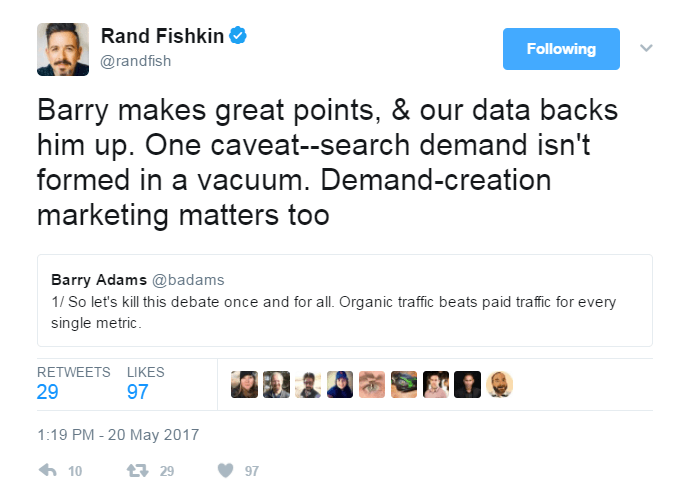
Last week, I had the misfortune of encountering perhaps the most misguided thread on digital marketing I’ve ever seen on Twitter (which is saying something), in which an SEO declared unequivocally that “organic search traffic beats paid traffic for every single metric.”

To me, these statements seemed outrageous and even inflammatory. But much to my surprise, many SEOs caught onto this thread and were all about it. Et tu, Rand?

Realistically, I’m not sure what data can truly back up these far-reaching statements declaring dominance of organic search performance over paid search in every metric. And Rand’s caveat fails to address the real problem of this thread, which is its narrow-minded, one-versus-the-other premise.
In reality, some searchers will click on ads. Others will click on organic links. Marketers should be trying to capture both.
Let’s talk about the current landscape and dive into how there are better, more nuanced ways to look at performance comparisons between paid search and SEO — without all the bluster.
Paid search growth has long outpaced organic growth
It’s no secret to paid search and SEO managers that Google has steadily made updates over the past couple of years that have directly harmed organic traffic, including the addition of a fourth text ad above organic links on desktop, the addition of a third (and then fourth) text ad above organic links on phones, doubling the size of Product Listing Ads on phones, moving the Local Pack to the top of search results, and more.
As a result, overall organic traffic has declined Y/Y for the past several quarters, as shown in this chart from the quarterly Merkle Digital Marketing Report (registration required).

You don’t have to take our word for it — take a look at Google’s Q1 2017 earnings report, which showed a 53 percent increase in paid clicks on Google properties Y/Y. Even though that includes other channels, the vast majority is search, and if you think that isn’t coming at the expense of organic — well, you’d be wrong.
I don’t say this because I’m a paid search hack trying to butter up PPC. Our agency manages SEO as well — and does a fantastic job of it. I even lauded the strong organic growth we were seeing a couple of years ago in a presentation at SMX Advanced about Google’s declining paid search click growth at the time. If we were seeing big organic growth overall, I’d be screaming it from the rooftops and saying that every marketer needs to be throwing all their resources at organic.
Unfortunately, that’s not the case — because again, Google has been steadily making changes that directly harm organic search and help to keep paid search click growth strong.

So right off the bat, we have one metric that paid search has an advantage in. This is going to vary from brand to brand, but overall, this is the way things are moving for most marketers.
But what about all those other metrics that are supposedly amazing for organic and terrible for paid search? Anyone who understands how to do such comparisons correctly would be careful to provide nuance and specificity in explaining how performance metrics should be analyzed. Unfortunately, Twitter is ill-suited for such details.
Here are two tips for anyone looking to derive meaningful comparisons between paid search and SEO.
1. Segment query types and devices
If most of your organic search traffic is coming from searches for your own brand name, but a smaller share of paid search traffic comes from branded queries, performance is going to vary. Shocking, I know. As such, you should be segmenting traffic and conversion performance by brand vs. non-brand, as well as doing category-level segmentations within those buckets.
This was made harder by the rise of [not provided] obfuscating organic queries in analytics packages, but is still possible using tools such as Google Search Console.
Similarly, organic and paid search might derive different shares of traffic from different device types for a given brand. Device types tend to perform differently in all sorts of metrics, from click-through rate to conversion rate to bounce rate. Thus, this would throw off any overall performance comparisons and require that metrics be broken down by device.
In the case of analysis that declares some overall winner with zero nuance about how data was segmented, it’s almost guaranteed the individual didn’t bother making such segmentations. Declaring such overarching results apply to every brand in existence is just ridiculous.
2. Take advantage of both paid and organic, and measure incrementality
But it’s not just about measuring how paid and organic search metrics compare on any given day. It’s also important to understand how they work together.
[Read the full article on Search Engine Land.]
Some opinions expressed in this article may be those of a guest author and not necessarily Marketing Land. Staff authors are listed here.
About The Author

Popular Stories
Related Topics
